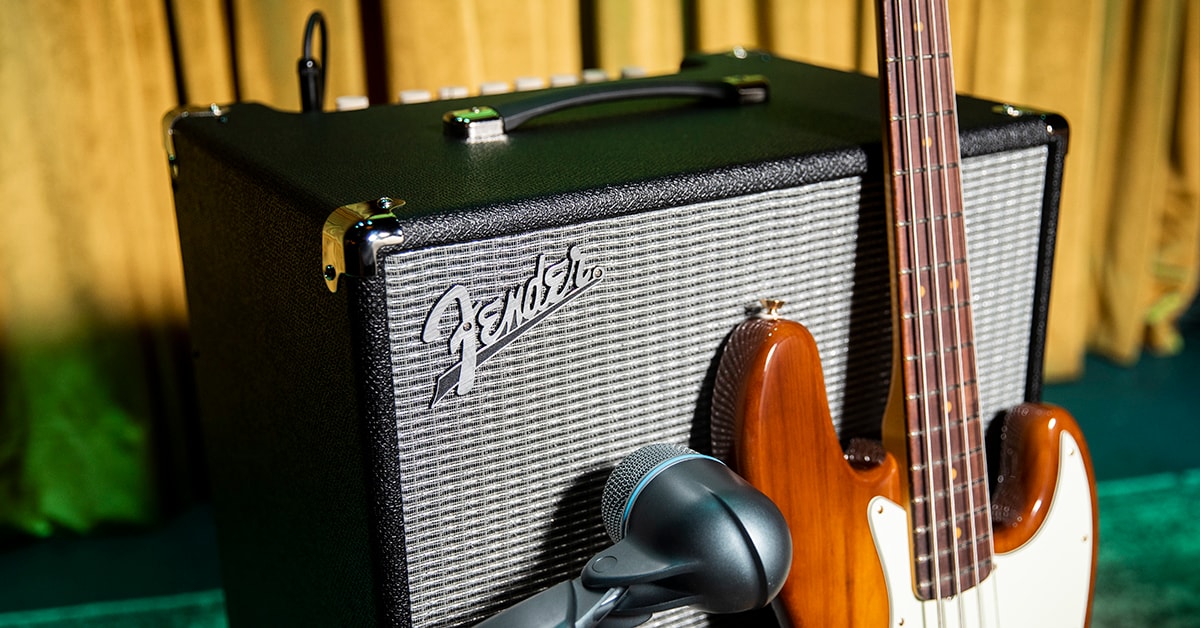You’re looking for the right bass amplifier to fit your style, sound and specific needs, and you’re in need of some trustworthy intel. Whether you’re just starting out and looking for your first amp, or a seasoned pro looking for the ideal stage or studio rig, we can help you navigate the world of combos, heads, tubes and hybrids to find just the right thump for your sound and budget.
Today, we’ll look at all the basics of bass amplification, from tube and solid-state technology to choosing a combo or head and cabinet. Is the same amp you practice with the right one for the stage? What’s the difference between recording with an amp or a DI? What the heck even is a hybrid amp?
Whether you’re looking for a tried-and-true classic or the latest in thunderous tone-shaping wonders, we can help you locate the right rig for the job.
Table of Contents
A Quick History of Bass Amplification
Best Bass Amps for Beginners
Best Bass Amps for Practice
Best Bass Amps for Recording
Best Bass Amps for Live Performance
In Closing
A Quick History of Bass Amplification
To understand where we are today, we need to understand where we came from. Two of the biggest names in bass, Ampeg and Fender, were the first innovators in bass amplification. The 1949 premiere of the Ampeg Super 800, soon followed by Fender’s 1952 release of the Bassman, set the standard for the industry by being the first truly viable gigging amp choices for bass players.
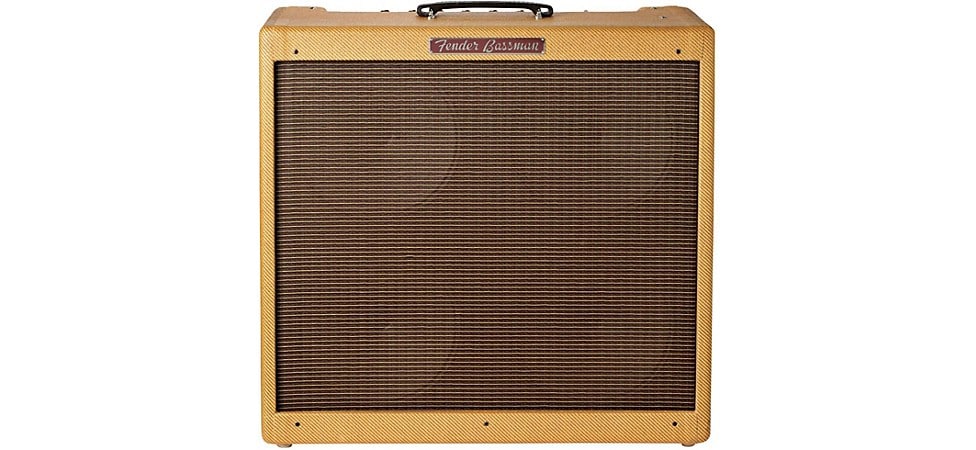
Pictured: Fender Vintage Reissue '59 Bassman LTD 4x10 Combo Amp
In 1960, Ampeg released the B-15 Portaflex, also known as the “flip top,” the gold standard of bass amplification favored by the biggest studio players in Detroit, Memphis and Los Angeles. It’s the holy grail of vintage bass amps today.
The 1960s also brought along solid-state technology. Where previous amps had all been tube-driven and powered (just like guitar amps), solid-state transistors made it possible to make lighter, more durable amps. VOX spearheaded this drive with their T.60, but soon the names you’ve grown to associate with bass amps entered the market, including Acoustic and Gallien-Krueger—the latter beginning with Bob Gallien’s GMT 226B, one of the most powerful bass amps of the ’60s.
You’ve probably heard the term SVT a lot when people talk about bass amps, but you may not really be sure what it means. Super Valve Technology was introduced by Ampeg in 1969, and it’s a tube technology that provides substantially more power, translating into volume and projection. Ampeg’s SVTs became the popular tube amplification choice for bass players throughout the 1970s, while solid-state aficionados flocked to the Acoustic 360 stack; a 200-watt head and massive rear-firing 18” speaker. Thus began the era of arena rock.
In the 1980s, bassist Dave Boonshoft was on the lookout for a bass preamp with the hi-fi quality of the preamps in Neve recording consoles. He met designer Alex Aguilar, and the next generation of bass amp technology was born. Aguilar Amplification pioneered onboard bass preamps, hum-free single-coil pickups and much more.
From the 1980s to the 2000s, bass amp technology continued to evolve and diversify. Big names like Peavey and Orange entered the field, as well as newcomers like Markbass and a host of boutique brands. Meanwhile, brands like Fender, Ampeg and Gallien-Krueger continued to push boundaries.
Best Bass Amps for Beginners
If you’re just starting out, all of this can be overwhelming. Fortunately, we have some good guidelines of what to look for, as well as some choice options for you.
A beginner’s amp is budget-friendly—often less than $200. The wattage typically stays below 50, and your speakers will likely be either 8” or 10”. Inclusion of headphone jacks in the amp are very beginner-friendly, especially for nighttime bedroom practice, and Bluetooth or AUX inputs give you some versatility. All of the beginner options we’re highlighting today feature headphone jacks.
Comparing the Best Bass Amps for Beginners
|
Model |
Wattage |
Speaker |
Controls |
Connectivity |
Price* |
|
25W |
8" custom ferrite speaker |
Volume, Overdrive, Shape, Low, Mid, High |
AUX in, headphone out |
$169.99 |
|
|
25W |
8" Fender-designed speaker |
Volume, Overdrive, Bass, Middle, Treble, Contour |
AUX in, headphone out |
$139.99 |
|
|
30W |
8" Ampeg-designed speaker |
Volume, Bass, Midrange, Treble, Super Grit Technology (SGT) overdrive |
0 and –15dB inputs, AUX in, headphone out |
$199.99 |
|
|
10W |
Two 5" VOX Bulldog speakers |
Drive, Bright, Treble, Bass, Volume |
Headphone out |
$169.99 |
Pricing as of December 2025*
Acoustic B25C Bass Combo With Tilt-Back Cab
The Lowdown: Great for home or rehearsal, the Acoustic B25C delivers big, bold bass tone in a compact, affordable package.
Things to Consider:
- Tilt-back cabinet assumes wedge position to better hear yourself at band practice
- Headphone output assures you won’t disturb others during late-night sessions
- 1/8" AUX input lets you connect a device to jam along with your favorite tunes
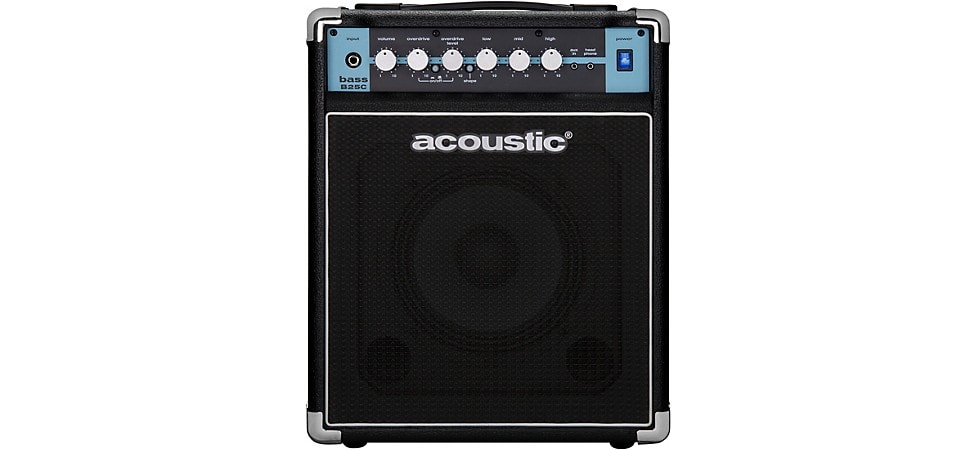
Shop Now: Acoustic B25C Bass Combo With Tilt-Back Cab
A top choice is the Acoustic B25C 1X8 25W Bass Combo With Tilt-Back Cab. It delivers just the right amount of power for practice and jamming with friends, and easily tilts back like a stage monitor for even better projection from that 8” ferrite speaker. It features simple 3-band EQ control and it also boasts an overdrive circuit and a handy Shape switch that provides quick midrange tone shaping. And the 25 watts of power are just right for getting great tone but not losing your roommates.
Fender Rumble 25 Bass Combo Amp
The Lowdown: The best-selling Fender Rumble 25 has earned the trust of 180+ bassists at Guitar Center, averaging 4.77 out of five stars for its tone, ease of use and accessibility.
Things to Consider:
- No-frills control layout with engageable overdrive circuit and mid-scoop contour switch
- Custom 8" speaker produces tight, punchy lows
- Timeless, retro-style Fender looks
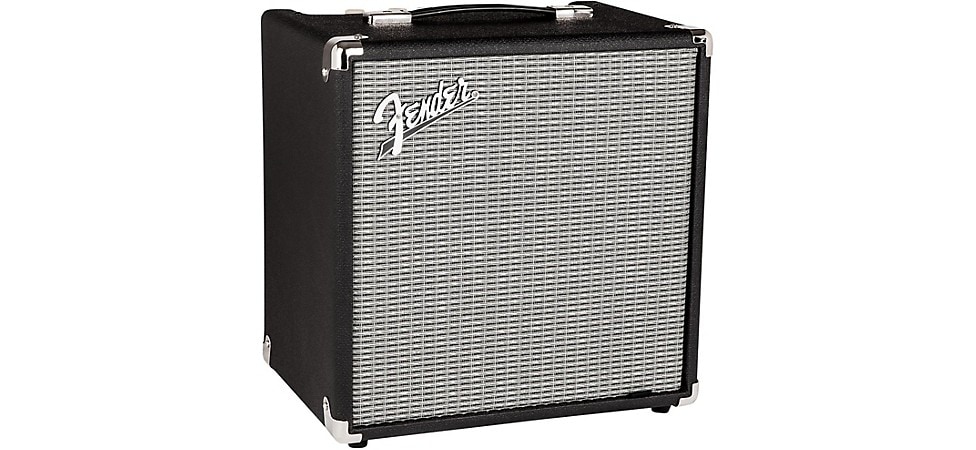
Shop Now: Fender Rumble 25 Bass Combo Amp
The Fender Rumble 25 1x8 25W Bass Combo Amp is another prime 25-watt, 8” speaker combo. It delivers the trusty round Fender tone we love, and carries a lot of power and volume for its modest footprint.
Ampeg Rocket Bass RB-108 Bass Combo Amp
The Lowdown: Scoring an unimpeachable 5/5 stars here at Guitar Center, bass players of all stripes love the Rocket Bass RB-108’s legendary Ampeg sound.
Things to Consider:
- Classic 3-band EQ and switchable Super Grit Technology overdrive circuit
- Equipped with the fabulous-sounding Ampeg Legacy preamp section
- Vintage-inspired aesthetic with a cool checkered vinyl wrap
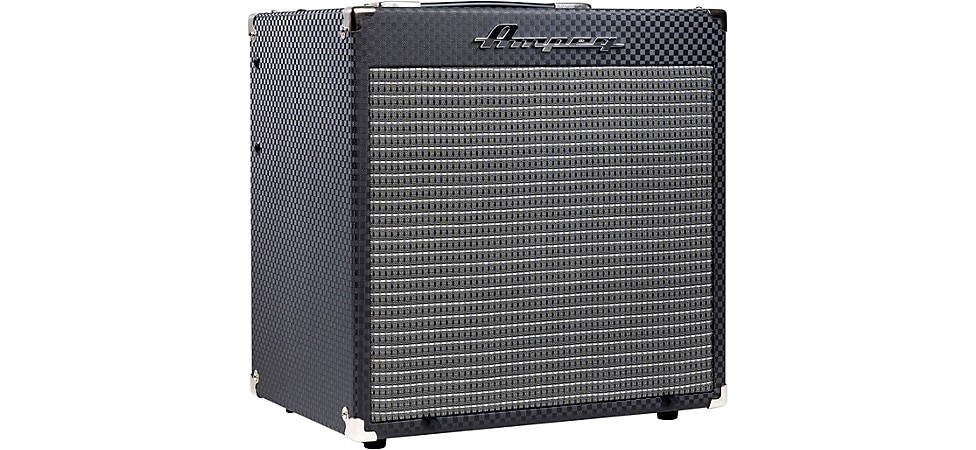
Shop Now: Ampeg Rocket Bass RB-108 Bass Combo Amp
Ampeg’s Rocket Bass series is appealing for a lot of reasons—vintage style, portability and heaps of luscious Ampeg bass sound. The Ampeg Rocket Bass RB-108 1x8 30W Bass Combo Amp is a 30-watt beauty that uses the same Ampeg Legacy preamp as pricier models, and includes Super Grit technology for a scrappy overdrive crunch.
VOX Pathfinder Bass Combo Amp
The Lowdown: The VOX Pathfinder lives up to its name as a truly take-anywhere bass combo, weighing only 12 pounds and outputting hefty sonics that belie its frame.
Things to Consider:
- Open-back cabinet allows low end to “bloom”
- Up the top-end sparkle by flicking on the Bright switch
- Drive control gives your bass sound some dirty edge
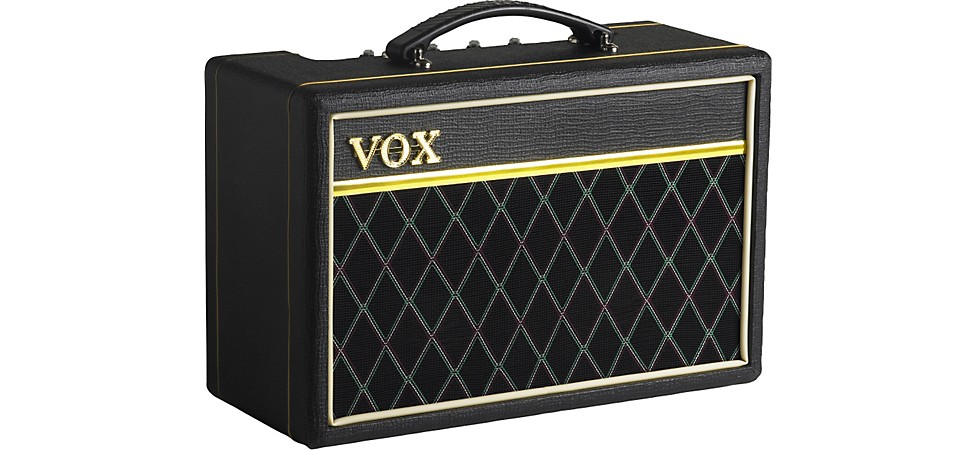
Shop Now: VOX Pathfinder Bass Combo Amp
The VOX Pathfinder 10W Bass Combo Amp is an offshoot of the widely loved Pathfinder guitar amp (a little solid-state marvel). This bass version boasts two 5” Bulldog speakers that really make the most of the amp’s modest 10 watts. Surprisingly loud and full, it also boasts a Drive option for a little extra something.
Best Bass Amps for Practice
Practice amps are a special and important breed—bigger and more powerful than beginner’s amps so that they can compete with drums, guitars, etc., but not so big that they’re sonic overkill or a nightmare to lug around.
Typical prices hover in the $300–600 range and the wattage often stays in the 100- to 200-watt range, although we’re including some more robust options here. This is where 12” and 15” speakers begin to come into play, in addition to 10” options. Again, headphone outputs and additional input options increase the bang you get for your buck.
Comparing the Best Bass Amps for Practice
|
Model |
Wattage |
Speaker |
Controls |
Connectivity |
Price* |
|
200W |
15" custom neodymium speaker |
Gain, Low, Mid Low, Mid High, High, VLE, VPF, Line Out level |
XLR in, 1/8" out, speakON out, tuner out, effects loop, XLR out |
$769.99 |
|
|
100W |
15" Orange-designed speaker |
Volume, Treble, Middle, Freq, Bass, Blend, Gain |
AUX in, headphone out, effects loop, XLR out |
$699.00 |
|
|
500W |
Two 10" Eminence ceramic magnet speakers |
Gain, Bright, Contour, Vintage, Drive, Level, Bass, Low Mid, High Mid, Treble, Master |
AUX in, headphone, out, effects loop, XLR out, 1/4" speaker out |
$679.99 |
|
|
300W |
Two 10" Peavey-designed speakers |
Gain, Bass, Middle, Treble, Volume, Overdrive, Contour, Mid Shift, Bright, Kosmos-C |
AUX in, headphone out, speakON out, effects loop, XLR out |
$549.99 |
Pricing as of December 2025*
Markbass CMD JB Players School 200-Watt Bass Combo Amp
The Lowdown: Named after influential jazz-rock bassist Jeff Berlin and his esteemed music school, this Markbass combo is a pro-grade amp masquerading as a practice utility.
Things to Consider:
- Markbass tone sounds killer with controls at noon
- Vintage Loudspeaker Emulator (VLE) knob works like a high cut
- Variable Preshape Filter (VPF) parameter recreates the classic “disco smile” EQ curve, boosting lows and highs while scooping mids
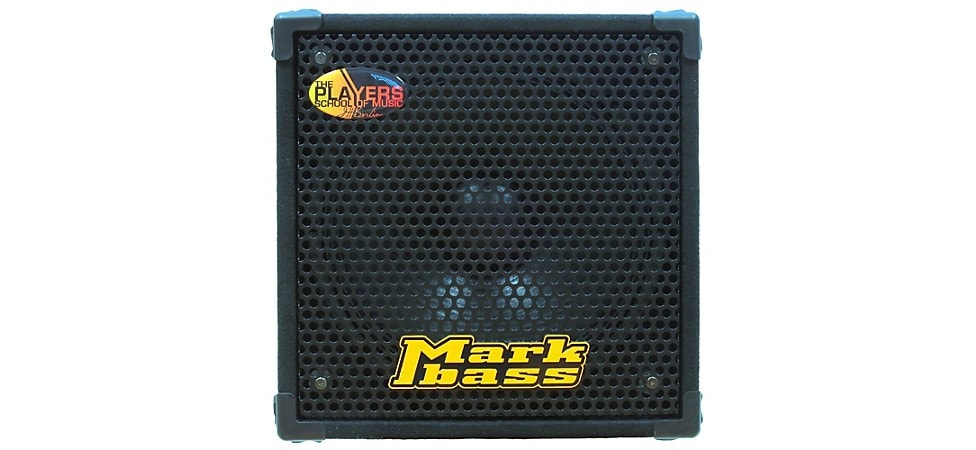
Shop Now: Markbass CMD JB Players School 200-Watt Bass Combo Amp
We recommend the Markbass CMD JB Players School 200W 1x15 Bass Combo Amp. It’s compact enough to work in your room, but with a 15” speaker pumping 200 watts, it packs more than enough punch for a rehearsal. Plus, the XLR output means you can record or run into a PA directly, adding to its versatility. The built-in Markbass Vintage Loudspeaker Emulator (VLE) rounds down your highs, fattening mids and lows, and pumping some nice vintage-style tone.
Orange Crush Bass 100 Bass Combo Amp
The Lowdown: From round and mellow to distorted and biting, the Orange Crush Bass 100 combo brings impressive sonic versatility to the table for bassists of any style.
Things to Consider:
- Parametric midrange EQ with selectable frequency from 300Hz–2.7kHz
- Built-in chromatic tuner ensures you’re always on pitch
- Optional FS-1 footswitch (sold separately) can toggle Blend/Gain circuits on/off
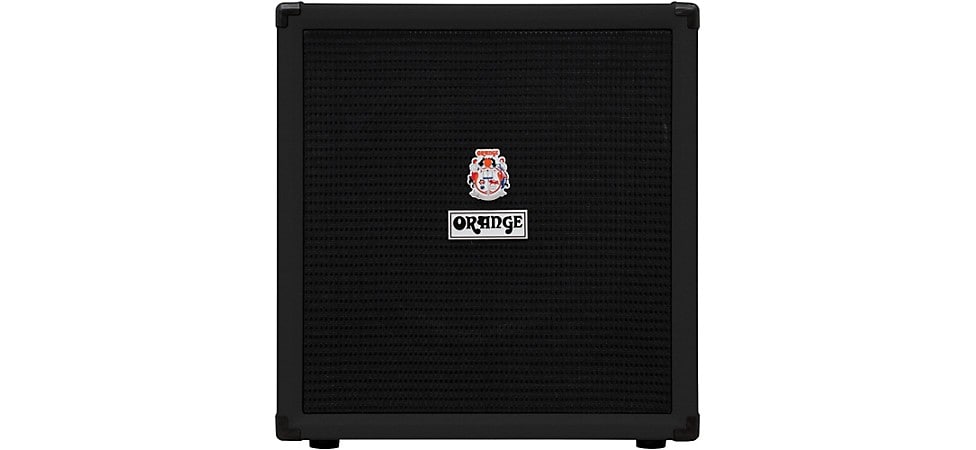
Shop Now: Orange Crush Bass 100 Bass Combo Amp
The Orange Crush Bass 100 100W 1x15 Bass Combo Amp is the little cousin of powerful and popular Orange 4 Stroke and OB1 series bass amps. It’s powerful enough for small venues, and produces voluptuous bass tone and sonic detail, thanks to active EQ and a bi-amp-inspired Gain and Blend circuit. Oh, did we mention the built-in effects loop and tuner?
Fender Rumble 500 Bass Combo Amp
The Lowdown: The significantly bigger brother to its 25-watt counterpart, the Fender Rumble 500 has gig-ready, window-rattling power—but sounds awesome at bedroom levels, too.
Things to Consider:
- High-end boosted Bright, mid-scooped Contour and tube-emulating Vintage tone voices
- Footswitchable overdrive circuit with dedicated Drive and Level controls
- Compression tweeter delivers crisp, detailed highs and can be turned on or off
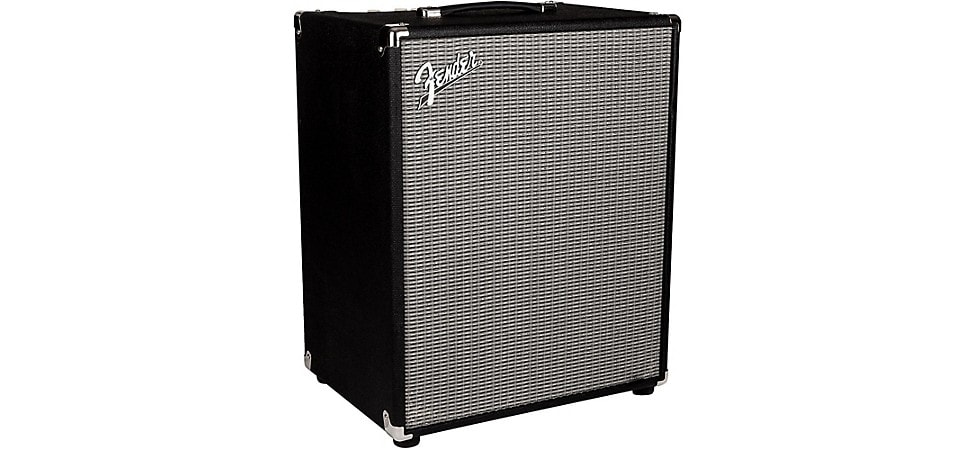
Shop Now: Fender Rumble 500 Bass Combo Amp
Fender steps up to the plate again with the Fender Rumble 500 2x10 500W Bass Combo Amp. At first glance, 500 watts might feel like overkill for a practice amp. But at this price, a powerhouse like this that can double as a gig amp is worth noting. It features two 10” Eminence-designed speakers, 4-band EQ, overdrive, an effects loop and a vintage tone switch.
Peavey MAX 300 Bass Combo Amp
The Lowdown: All-out performance is the Peavey MAX’s modus operandi, and it excels in terms of tonal variety and air-pushing power.
Things to Consider:
- Dedicated inputs for active or passive pickups
- Onboard chromatic tuner with a handy mute switch
- Unique Kosmos-C switch enhances low end with extra harmonic and subharmonic content
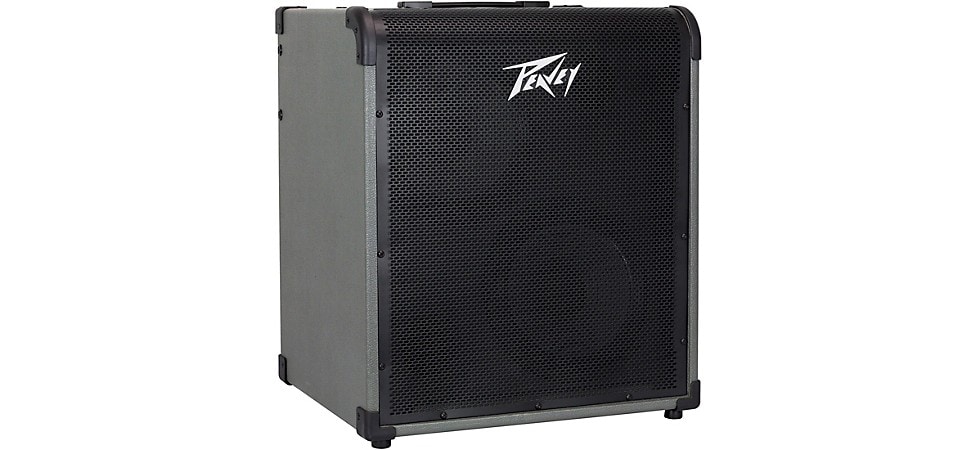
Shop Now: Peavey MAX 300 Bass Combo Amp
If you’re looking for rugged and dependable, the Peavey MAX 300 300W 2x10 Bass Combo Amp is your buddy. With a housing built for punishment and Peavey’s DDT speaker protection, which compresses your signal when you’re pushing it hard, this amp can handle nearly anything. Plus, Peavey’s Trans Tube circuitry is designed to provide tube-like warmth with solid-state convenience.
Best Bass Amps for Recording
Quality and sonic personality are at the forefront in choosing an amp to record bass. Before your signal even goes into the board or the computer, you want the best possible sound. Versatility is also huge here, especially if you are a session player recording with different artists in different genres.
Wattage and speaker size can be nearly anything in recording amps, because you’re working in a very controlled environment. This is the first time in this guide we’ll recommend some amp heads, because they work just as well as combos for recording—just remember to budget for a speaker cabinet to go with it.
Comparing the Best Bass Amps for Recording
|
Model |
Wattage |
Speaker |
Controls |
Connectivity |
Price* |
|
900W |
N/A |
Comp, Drive, Level, Mod, Blend, Gain, graphic EQ, Master, Distortion, Bite, Growl |
AUX in, headphone out, MIDI, USB, effects loop, speakON out, XLR out |
$1,499.99 |
|
|
300W |
N/A |
Channel one: Volume, Treble, Midrange, Bass; Channel two: Volume, Treble, Bass |
XLR out, speakON out, 1/4" speaker out |
$3,499.99 |
|
|
800W |
N/A |
Pad, Drive, Level, Bass, Lo Mid, Hi Mid, Treble, Master, Boost, Edge, Bump, Contour, Presence, Mute |
AUX in, headphone out, effects loop, tuner out, speakON out, XLR out |
$1,049.00 |
Pricing as of December 2025*
Darkglass Alpha•Omega 900 Bass Amp Head
The Lowdown: The beginning and end of your tone journey, the Darkglass Alpha•Omega is a pint-sized powerhouse packed with record-ready features.
Things to Consider:
- 6-band graphic equalizer is as sonically flexible as it is intuitive
- Renowned Alpha•Omega distortion engine goes from mild to wild
- Pairs with IR-loading Darkglass Suite desktop software
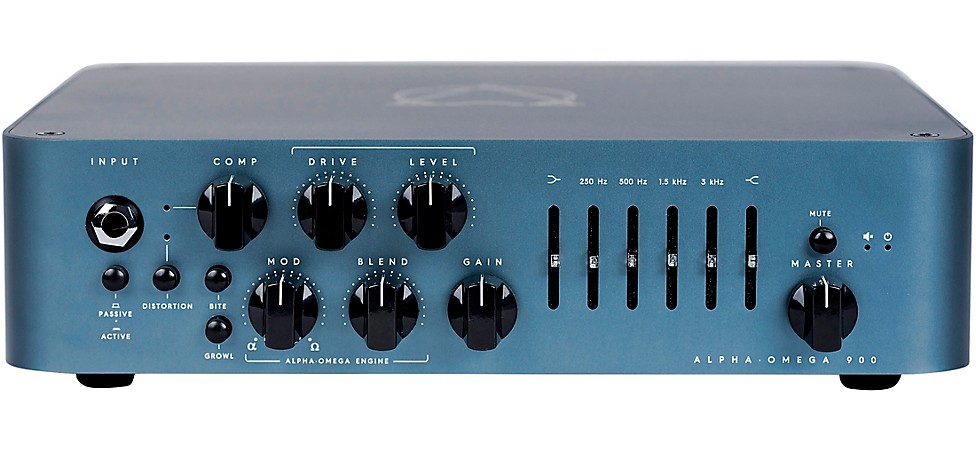
Shop Now: Darkglass Alpha•Omega 900 Bass Amp Head
With a jaw-dropping 900 watts of power, the Darkglass Alpha•Omega 900 900W Bass Amp Head is a beauty of a beast. Darkglass combined elements of their hugely popular Alpha and Omega distortion engines with cutting-edge features, including Bite and Growl modes, built-in compression and an impulse response cabinet simulation that let you store up to three virtual cabinets—that means you can dial in your entire rig sound before it even hits a speaker or a recording device.
Ampeg Heritage 50th Anniversary SVT Tube Bass Amp Head
The Lowdown: Winner of a NAMM TEC Award at the 36th annual show, the Ampeg Heritage 50th Anniversary SVT tube head looks and sounds the part of celebrated vintage bass amplifiers.
Things to Consider:
- Two distinct channels with the option to jump them for a third voice
- Bright and Normal inputs with two jacks each
- Five rocker switches help fine-tune your tone
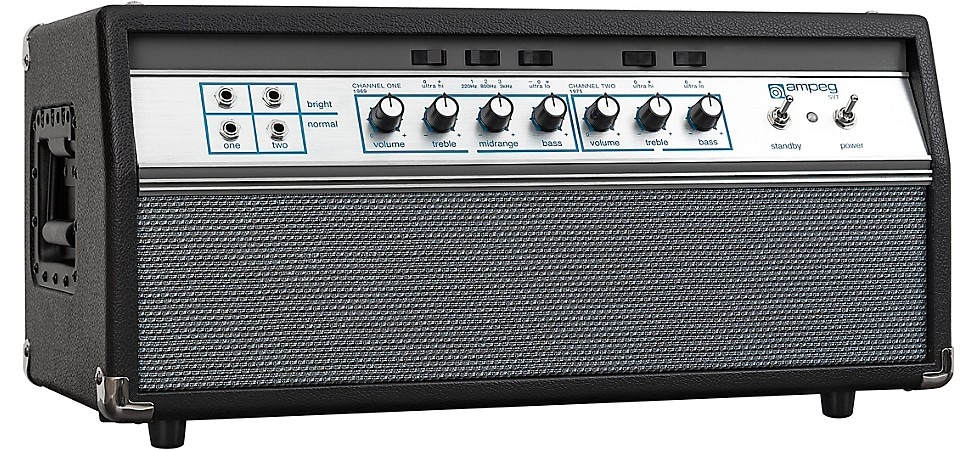
Shop Now: Ampeg Heritage 50th Anniversary SVT Tube Bass Amp Head
The Ampeg Heritage 50th Anniversary SVT 300W Tube Bass Amp Head revisits the industry-changing debut of Super Valve Technology—the moment bass players finally had the power to compete with walls of guitar amps. This model features the tone of the 1969 Blueline original and the mid-1970s Magnavox design, plus the option to blend the two. This beauty is made in the U.S.A., and boasts modern improvements, including a fan to promote tube longevity and speakON outputs.
Gallien-Krueger Legacy 800 Bass Amp Head
The Lowdown: The Gallien-Krueger Legacy 800 recalls classic bass tones from the ’80s—vibrant sounds that are still as fresh and inspiring as ever.
Things to Consider:
- Includes a footswitch to operate the overdrive circuit
- XLR D.I. output with pre- or post-EQ switch
- 4-band EQ and three voicing filters
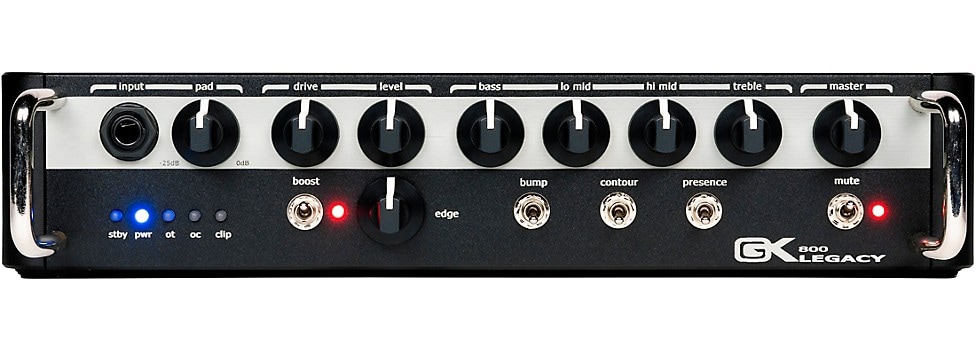
Shop Now: Gallien-Krueger Legacy 800 800W Bass Amp Head
Gallien-Krueger also revisits a landmark amp with the Gallien-Krueger Legacy 800 800W Bass Amp Head. The 800RB was a breakout hit in the 1980s, admired for its power, clarity and growl. This model captures all of that while adding modern advancements, including gold-plated connectors, to protect against the damage of temperature extremes and vibration from frequent use. It also boasts Bump, Contour and Presence voicing features.
Best Bass Amps for Live Performance
While power is a prime driver in the choice of a gigging bass amp, that doesn’t mean it has to come at the expense of tone and subtlety. The size of the venues you typically play and the amount of traveling you do are important factors, too—you don’t need to lug a giant stack across town to play a coffeehouse, but you’ll struggle to be heard with a small combo in a club with a loud band and boisterous crowd.
Gigging amps generally range from $750 to upwards of $3,000, and if you consider the heads we recommend below, you’ll need to account for the additional cost of a speaker cabinet. Also, some venues provide backline gear, in which case you can just bring your head and plug into their provided cabinet. Call ahead to make sure that their cab will be a good fit for your amp.
Comparing the Best Bass Amps for Live Performance
|
Model |
Wattage |
Speaker |
Controls |
Connectivity |
Price* |
|
700W |
N/A |
Comp, Super Grit Technology, Grit Level, Gain, Bass, Mid, Freq, Treble, Volume |
AUX in, headphone out, effects loop, speakON out, XLR out |
$899.99 |
|
|
500W |
N/A |
Gain, Mid Level, Mid Freq, Bass, Treble, Drive, Volume |
AUX in, headphone out, effects loop, tuner out, USB-C, speakON out, XLR out |
$999.99 |
|
|
300W |
Two 10" neodymium speakers |
Gain, Low, Mid Low, Mid High, High, Old School, Master, Line Out level |
Effects loop, tuner out, speakON out, XLR out |
$1,199.99 |
|
|
500W |
Two 10" Lavoce speakers |
Super Grit Technology, Volume, Bass, Midrange, Treble |
AUX in, headphone out, effects loop, XLR out, extension speaker out |
$749.99 |
Pricing as of December 2025*
Ampeg SVT-7 PRO Bass Amp Head
The Lowdown: The Ampeg Venture V7 is a tonally adaptable and extremely portable choice for gigging bassists.
Things to Consider:
- Super Grit Technology overdrive circuit with SVT and B15 voicings
- Built-in one-knob compressor
- 700-watt Class-D power section can drive virtually any cabinet
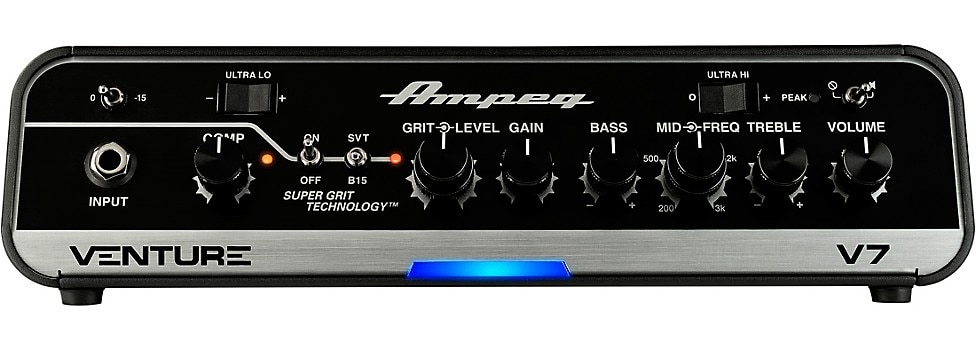
Shop Now: Ampeg Venture V7 Bass Amplifier Head
Compact, lightweight and exceptionally powerful, the Ampeg Venture V7 bass amp head delivers huge sound in a small package. Highlights include the multi-voice overdrive section with saturation styles inspired by classic Ampeg bass amps, as well as an easy-to-use compressor circuit and sweepable midrange frequency to really hone your tone. Its balanced D.I. output is perfect for reliably sending a signal straight to front-of-house or to a recording device in the studio, but you’ll probably still want to hook up a matching cabinet and let the Venture V7’s 700 watts of Class-D power move some serious air.
Aguilar Tone Hammer Bass Amp Head
The Lowdown: The Tone Hammer 500 V2 is a small, practical solution for performing bassists who want tube-like sound from a solid-state amplifier.
Things to Consider:
- Classic 3-band EQ with a selectable midrange frequency
- Drive control adds distortion and valve-style grittiness to the signal
- USB-C connectivity and three onboard IRs for recording flexibility
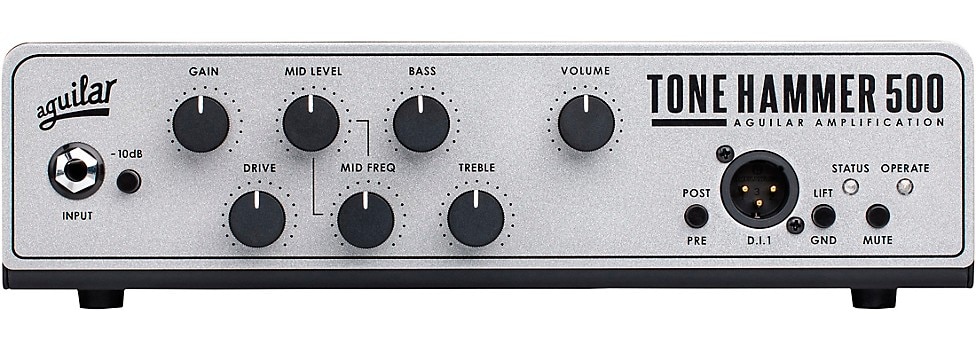
Shop Now: Aguilar Tone Hammer Bass Amp Head
The Aguilar Tone Hammer 500 Bass Amp Head is based on their popular Tone Hammer pedal, which is one of the most respected, tone-saving DIs on the scene. This head combines the pedal’s tonal versatility and gain-shaping circuitry with 500 watts of pure power. Whether you prefer velvety round tone, biting overdrive or cutting solo bass sounds, this puppy can give it to you. It boasts both speakON and XLR outputs, meaning you can run it directly into the PA, just like a DI.
Markbass CMD 102P Bass Combo Amp
The Lowdown: For outstanding projection and sound that cuts through the mix on stage, the Markbass CMD 102P bass combo is a standout choice.
Things to Consider:
- Old School knob filters high frequencies for a round, smooth sound
- Bi-band limiter offers fast, dynamic response and a more natural top end
- 4-band EQ with ±16dB of play in either direction (boost or cut)
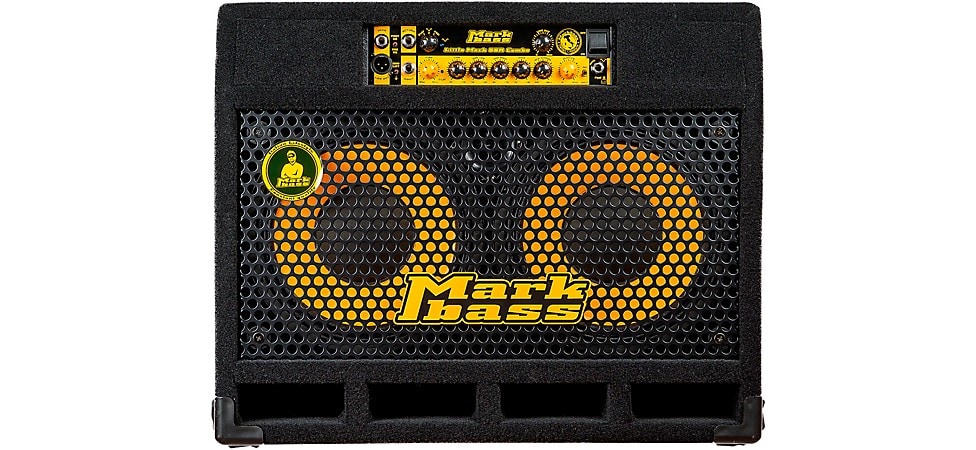
Shop Now: Markbass CMD 102P Combo Amp
In the combo arena, the Markbass CMD 102P provides 300 watts of power courtesy of two 10” neodymium speakers in a housing that tilts back like a stage monitor for fantastic projection. It makes the most of its updated 4-band EQ, and it features a piezo tweeter to project your treble and high mids, cutting through competing sound.
Ampeg Rocket Bass RB-210 Bass Combo Amp
The Lowdown: This Ampeg combo brings legendary tone and gig-ready power together in a streamlined cabinet.
Things to Consider:
- Ampeg Legacy preamp with 3-band EQ
- Weighs only 39 pounds for portability
- ’60s-style black checkered Tolex and sparkle grille cloth
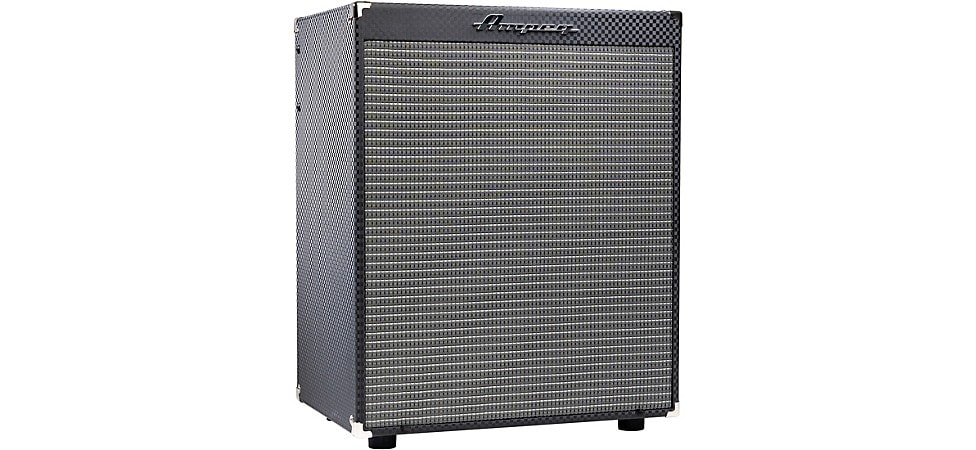
Shop Now: Ampeg Rocket Bass RB-210 Bass Combo Amp
The Ampeg Rocket Bass RB-210 2x10 500W Bass Combo Amp has vintage good looks, Super Grit overdrive and two 10” Eminence speakers to proudly broadcast 500 watts of power. This combo captures all the best elements of gigging, recording and practice amps, with headphone out, XLR out and AUX input.
In Closing
Despite the vast array of options, the best bass amp for your specific needs can be pretty simple to find. Just try some out. Head down to your local Guitar Center and plug into a few of these options and judge for yourself. Trusting your ear, your unique style and your preferred sound will always lead you in the right direction.
Also, the classic amps we mentioned at the beginning often pop up in our vintage collection, and we’re always adding to our arsenal of used gear, so keep an eye out.
.jpeg)






